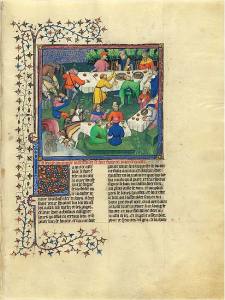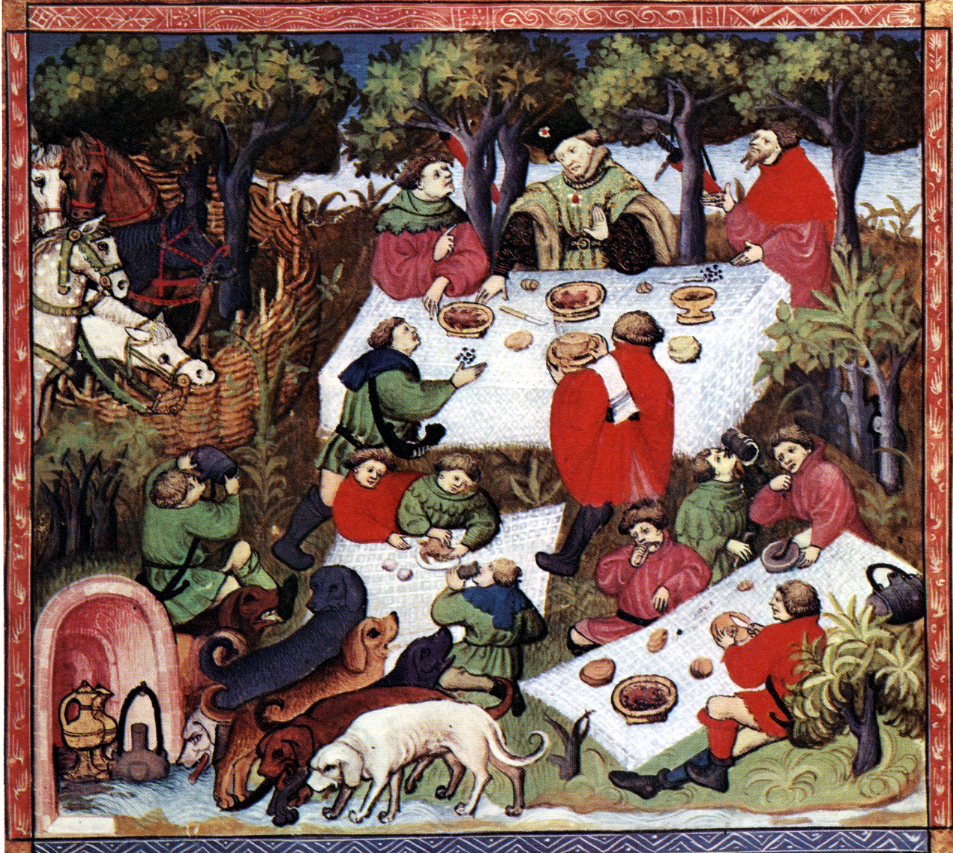Gaston III’s The Book of Hunt formalized the hunter’s assemblée as the model for a meal during a hunt. It is not a picnic. Gaston did not intend this gathering as a luncheon but as an early morning meeting during which the day’s hunt was discussed and planned. Methodically, Gaston describes “How the Assembly (Assemblée) should be in Summer and Winter.” But an illustration of illustration for a 1407 edition of the book shows the hunters dining on the grass in a forest clearing. Creating the impression that this is a picnic, which it is not.

“The Gathering in Winter and Summer, In The Book of Hunting,” Le livre de la chasse]. Paris:1407c.; http://www.themorgan.org/collection/livre-de-la-chasse/24
Confusion rests on the fact that hunters and staff at Gaston’s assemblée are served meats, cold game, bread, and wine. However, this is not a picnic but a working meeting of hunters discussing the coming day’s hunt. However, this is not a picnic but a gathering of hunters, the aim of which is the chief tracker’s presentation of fumes, or deer turds, to the master of the hunt.
Gaston’s hunters form three main groups, each sitting based on rank: the lord and attendants at a large table, principal hunters at a smaller table, and valets, pages, and servants at cloth on the grass. According to etiquette, bread marks a place setting. Diners used their hands and a knife; forks were not used, dining on meats, cold game, bread, and wine.
The shift from an early morning meeting to discuss plans for the day’s hunter soon evolved into a midday break for refreshment. Such a gathering first appears as un repas de chasse or halte de chasse in Jacques du Fouilloux’s Hunting (1560) and again in George Gascoigne’s English translation The Noble Arte of Venerie or Hunting (1575). Gascoigne’s repas de chasse features Elizabeth I (an avid hunter) as the guest of honor.
Over the next five centuries, repas de la chasse or halte de chasse became a standard. The French aristocracy, fond of hunting scenes, patronized Watteau and others of his ilk for haltes de chasse. By 1825, Brillat-Savarin recommended it as a most glorious meal rivaling any salon dining experience.
*Gaston III, Count of Foix, was nicknamed Phébus for his golden hair. He was a second-tier noble of Béarn in southwestern France who was immensely rich, unlucky in love, and passionate about hunting. Le livre de la chasse, published in (1389), is considered the most comprehensive hunting manual ever.
Featured Image: “How the Assembly should be in Summer and Winter,” In The Book of Hunting, [Le Livre de la chasse], Paris:15th Century; http://classes.bnf.fr/phebus/grands/c38_616.htm;
See Richard Vernier. Lord of the Pyrenees: Gaston Fébus, Count of Foix 1331-1391. Woodbridge, Sussex: The Boydell Press, 2008; Gaston III Phébus, Count de Foix. The Hunting Book of Gaston Phébus (1389). Translated by Wilhelm Schlag. London: Harvey Miller Publishers, Reprint, 1998; Illuminating the Medieval Hunt, The Morgan Library & Museum (2008), http://www.themorgan.org/exhibitions/illuminating-the-medieval-hunt

